North American F-86D Sabre
The North American F-86D/K/L Sabre (initially known as the YF-95 and widely known informally as the "Sabre Dog",[1]) was an American transonic jet interceptor. Developed for the United States Air Force in the late 1940s, it was an interceptor derivative of the North American F-86 Sabre. While the original F-86 Sabre was conceived as a day fighter, the F-86D was specifically developed as an all-weather interceptor. Originally designated as the YF-95 during development and testing, it was re-designated the F-86D before production began, despite only sharing 25% commonality of parts with the original F-86. Production models of the F-86D/K/L differed from other Sabres in that they had a larger fuselage, a larger afterburning engine, and a distinctive nose radome. The most-produced Sabre Dog variants (the "D" and "G" models) also mounted no guns, unlike the Sabre with its six M3 Browning .50 caliber machine guns, instead mounting unguided “Mighty Mouse” air-to-air rockets (the "K" and "L" Sabre Dog variants mounted four 20mm M24A1 cannon).
| F-86D/K/L Sabre | |
|---|---|
.jpg.webp) | |
| A USAF North American F-86D | |
| Role | All-weather fighter-interceptor |
| National origin | United States |
| Manufacturer | North American Aviation |
| First flight | 22 December 1949, 74 years ago |
| Introduction | circa 1952 |
| Retired |
|
| Primary users | United States Air Force Italian Air Force SFR Yugoslav Air Force Japanese Air Self-Defense Force |
| Number built | 2,847 |
| Developed from | North American F-86 Sabre |
Design and development
The YF-95 was a development of the F-86 Sabre, the first aircraft designed around the new 2.75-inch (70 mm) "Mighty Mouse" Folding-Fin Aerial Rocket (FFAR). Begun in March 1949, the unarmed prototype, 50-577, first flew on 22 December 1949, piloted by North American test pilot George Welch and was the first U.S. Air Force night fighter design with only a single crewman and a single engine, a J47-GE-17 with afterburner rated at 5,425 lbf (24.1 kN) static thrust. Gun armament was eliminated in favor of a retractable under-fuselage tray carrying 24 unguided Mk. 4 rockets, then considered a more effective weapon against enemy bombers than a barrage of cannon fire. A second prototype, 50-578, was also built, but the YF-95 nomenclature was short-lived as the design was subsequently redesignated YF-86D.
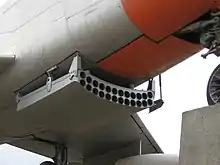
The fuselage was wider and the airframe length increased to 40 ft 4 in (12.3 m), with a clamshell canopy, enlarged tail surfaces and AN/APG-36 all-weather radar fitted in a radome in the nose, above the intake. Later models of the F-86D received an uprated J-47-GE-33 engine rated at 5,550 lbf (24.7 kN) (from the F-86D-45 production blocks onward). A total of 2,504 D-models were built.
Operational history
On 18 November 1952, F-86D 51-2945 set a speed record of 698.505 mph (1,124.1 km/h). Captain J. Slade Nash flew over a three km (1.8 mi.) course at the Salton Sea in southern California at a height of only 125 ft (38 m). Another F-86D broke this world record on 16 July 1953, when Lieutenant Colonel William F. Barns, flying F-86D 51-6145 in the same path of the previous flight, achieved 715.697 mph (1,151.8 km/h).[2]

Variants
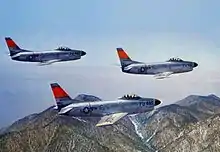
- YF-95A
- prototype all-weather interceptor; two built; designation changed to YF-86D (North American model NA-164)
- YF-86D
- originally designated YF-95A.
- F-86D
- Production interceptor originally designated F-95A, 2,504 built.
- F-86G
- Provisional designation for F-86D variant with uprated engine and equipment changes, 406 built as F-86Ds.
- YF-86K
- Basic version of F-86D intended for export with rocket tray replaced by four 20 mm cannon and simplified fire control system, two conversions.
- F-86K
- NATO version of F-86D; MG-4 fire control system; four 20 mm M24A1 cannon with 132 rounds per gun; APG-37 radar. 120 were built by North American, 221 were assembled by Fiat.
- F-86L
- Upgrade conversion of F-86D with new electronics, extended wingtips and wing leading edges, revised cockpit layout, and uprated engine; 981 converted.
Operators
- Source: Dorr[3]

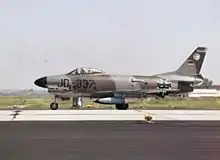
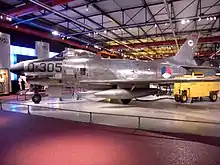
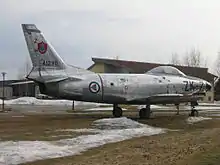
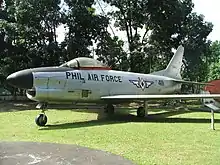
- Received 59 ex-USAF F-86Ds 1958-1960; assigned to 723, 726 and 728 Squadrons.
 France
France
- Fiat built 62 F-86Ks for France (1956-1957), assigned to EC 1/13 "Artois", EC 2/13 "Alpes", and EC 3/13 "Auvergne" Squadrons. Serials were 55-4814/4844, 55-4846/4865, 55-4872/4874, 55-4876/4879.
 West Germany
West Germany
- Acquired 88 U.S. F-86Ks 22 July 1957–23 June 1958. The Ks were assigned to Jagdgeschwader 75/renamed 74.
 Greece
Greece
- Acquired 35 F-86Ds from the US. Were received in 1961 and retired in 1967 but kept as back up until 1969. F-86D was the first all weather fighter in Greek Air Force. F-86Ds were assigned to 337 and 343 Squadrons. Until 1964 they were in natural metal. Until after retirement they were in NATO camo.
 Honduras
Honduras
- Acquired Six Venezuelan F-86Ks in 1970.
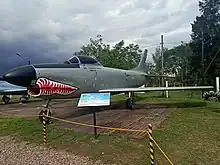 A former Honduran F-86K in Honduran Aviation Museum in Tegucigalpa, Honduras
A former Honduran F-86K in Honduran Aviation Museum in Tegucigalpa, Honduras  Italy
Italy
- Fiat produced 121 F-86Ks for Italy, 1955-1958. Also, 120 U.S. F-86Ks were acquired. F-86s were assigned to the AMI air groups: 6 Gruppo COT/1 Stormo, 17 Gruppo/1 Stormo, 23 Gruppo/1 Stormo, 21 Gruppo/51 Aerobrigata, 22 Gruppo/51 Aerobrigata and 12 Gruppo/4 Aerobrigata.
 Japan
Japan
- Acquired 122 US F-86Ds, 1958–1961; assigned to four all-weather interceptor Hikōtai, and Air Proving Ground at Gifu.
 Netherlands
Netherlands
- Royal Netherlands Air Force (Koninklijke Luchtmacht) (KLu)
- Acquired 57 U.S.-built and six Fiat-built F-86K Sabres, 1955–1956; and assigned to three squadrons, No. 700, 701 and 702. Operated until 1964.
 Norway
Norway
- Acquired 60 U.S.-built F-86K Sabres, 1955–1956, and four Italian-assembled Fiat K-models.
.svg.png.webp) Philippines
Philippines
- Acquired 20 F-86Ds, assigned to 8th Fighter Interceptor Squadron "Vampires" beginning 1960; part of the U.S. military assistance package.
 South Korea
South Korea
- Acquired 40 F-86Ds, beginning 20 June 1955.
 Republic of China (Taiwan)
Republic of China (Taiwan)
- Acquired 20 F-86Ls.
 United States
United States
- Acquired 32 US-built F-86Fs, October 1955–December 1960; 1965 acquired 79 Fiat-built F-86Ks from West Germany.
.svg.png.webp) Yugoslavia
Yugoslavia
- Acquired 130 U.S.-made F-86Ds and operated them between 1961 and 1974. 32 of these were modified into a reconnaissance variant utilizing 3 Kodak K-24 cameras mounted in place of the FFAR rockets, the IF-86D.[4]
Surviving aircraft
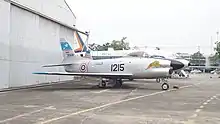
Specifications (F-86D-40-NA)
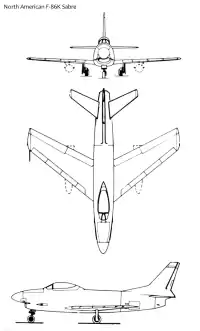
Data from Combat Aircraft since 1945,[1] The American Fighter[5]
General characteristics
- Crew: one
- Length: 40 ft 3 in (12.27 m)
- Wingspan: 37 ft 1.5 in (11.31 m)
- Height: 15 ft 0 in (4.57 m)
- Empty weight: 13,518 lb (6,132 kg)
- Gross weight: 19,975 lb (9,060 kg)
- Powerplant: 1 × General Electric J47-GE-17B , 5,425 lbf (24.13 kN) thrust dry, 7,500 lbf (33 kN) with afterburner
Performance
- Maximum speed: 715 mph (1,151 km/h, 621 kn) [6]
- Maximum speed: Mach .93
- Range: 330 mi (531 km, 290 nmi)
- Service ceiling: 49,750 ft (15,163 m)
- Rate of climb: 12,150 ft/min (61.7 m/s)
Armament
- 24 × 2.75 in (70 mm) Mighty Mouse FFAR rockets in ventral tray
Avionics
- AN/APG-36 all-weather radar
See also
- Aerospace Defense Command
- North American Aerospace Defense Command
- Semi-Automatic Ground Environment
Related development
- CAC Sabre
- Canadair Sabre
- North American F-86 Sabre
- North American F-100 Super Sabre
- North American FJ-1 Fury
- North American FJ-2/-3 Fury
- North American FJ-4 Fury
- North American YF-93
Aircraft of comparable role, configuration, and era
- Douglas F3D Skyknight
- Douglas F4D Skyray
- Fiat G.91
- Lockheed F-94 Starfire
- Mikoyan-Gurevich MiG-17
- Northrop F-89 Scorpion
- Saab 29 Tunnan
- Supermarine Swift
Related lists
References
Notes
- Wilson 2000, p. 111.
- "William F. Barns Archives". This Day in Aviation. February 21, 2019. Retrieved May 14, 2019.
- Dorr 1993, pp. 65–96.
- "IF-86D". Achtung, Skyhawk!. Retrieved 2022-04-18.
- Angelucci and Bowers 1987, pp. 346–47.
- Boyne, W.J. (1998). Beyond the Wild Blue: A History of the U.S. Air Force, 1947-1997. Thomas Dunne. St. Martin's Press. p. 380. ISBN 978-0-312-18705-7. Retrieved May 14, 2019.
Bibliography
- Allward, Maurice. F-86 Sabre. London: Ian Allan, 1978. ISBN 0-7110-0860-4.
- Angelucci, Enzo and Peter Bowers. The American Fighter: the Definite Guide to American Fighter Aircraft from 1917 to the Present. New York: Orion Books, 1987. ISBN 0-517-56588-9.
- Curtis, Duncan. North American F-86 Sabre. Ramsbury, UK: Crowood, 2000. ISBN 1-86126-358-9.
- Dorr, Robert F. F-86 Sabre Jet: History of the Sabre and FJ Fury. St. Paul, Minnesota: Motorbooks International Publishers, 1993. ISBN 0-87938-748-3.
- Käsmann, Ferdinand C.W. Die schnellsten Jets der Welt: Weltrekord- Flugzeuge (in German). Oberhaching, Germany: Aviatic Verlag-GmbH, 1994. ISBN 3-925505-26-1.
- Knaack, Marcelle Size. Encyclopedia of US Air Force Aircraft and Missile Systems, Volume 1, Post-World War Two Fighters, 1945-1973. Washington, DC: Office of Air Force History, 1978. ISBN 0-912799-59-5.
- Robinson, Robbie. NATO F-86D/K Sabre Dogs. Le Havre, 2018, 120 p. ISBN 978-2-9541818-3-7.
- Swanborough, F. Gordon. United States Military Aircraft Since 1909. London: Putnam, 1963. ISBN 0-87474-880-1.
- Wagner, Ray. American Combat Planes - Second Edition. Garden City, New York: Doubleday and Company, 1968. ISBN 0-370-00094-3.
- Wagner, Ray. The North American Sabre. London: Macdonald, 1963. No ISBN.
- Westrum, Ron. Sidewinder. Annapolis, Maryland: Naval Institute Press, 1999. ISBN 1-55750-951-4.
- Wilson, Stewart. Combat Aircraft since 1945. Fyshwick, ACT, Australia: Aerospace Publications Pty Ltd, 2000. ISBN 1-875671-50-1.